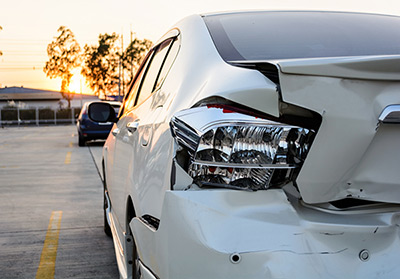If a rear-end crash happened, a free case review is offered by GJEL Accident Attorneys. No fee is charged unless a recovery is made.
Your rights can be protected and your claim can be advanced now.

Who is at fault for a rear-end crash in California
The following driver is usually at fault because California law requires a safe following distance under CVC 21703. Fault can shift to the lead driver if there is an unsafe sudden stop without proper signaling under CVC 22109, an unsafe lane change, or inoperable brake lights. Liability can also be shared under pure comparative negligence in California.
Rear-end crashes are among the most common collisions in the United States, with about 1.7 million per year and roughly 500,000 injuries. Fatal rear-end crashes are a small fraction of overall roadway deaths, which totaled about 40,900 in 2023.
On this page
Fault and exceptions | Comparative negligence | Deadlines | Evidence | Common injuries | Settlements | How the process works | FAQ
Additional results can be reviewed on our case results page. Facts, injuries, and venues vary, so every case is different.
Causes of Rear-End Collisions and Determining Fault
Following too closely is a common cause. A crash can occur when a vehicle ahead slows or stops and there is not enough distance to react. When driver distraction or speeding is present, risk increases. Vehicle maintenance can matter too. Worn brakes or inoperable brake lights can become evidence.
The rear driver is not always at fault. Examples include unsafe lane changes by a lead driver, sudden stops without signaling under CVC 22109, nonfunctioning brake lights, and chain reaction impacts where force pushes a middle vehicle forward. A manufacturer defect in braking components can also play a role.
Presumptions are helpful, but each claim is evidence driven. California’s safe following rule is set by CVC 21703. Exceptions are proven with facts from the scene, cameras, and reports.
Comparative Negligence in California
California applies pure comparative negligence from the Supreme Court’s decision in Li v. Yellow Cab. Juries are instructed under CACI 405 to assign percentages of responsibility. Any recovery is reduced by the percentage assigned to the injured person. A clear, complete record tends to improve outcomes.
Deadlines That Control Your Case
Most injury lawsuits in California must be filed within 2 years under CCP 335.1. If a public entity is involved, a government claim is usually required within 6 months under Gov. Code 911.2. Missing a deadline can bar a claim, so prompt action is recommended.
Evidence That Strengthens Rear-End Claims
Good claims tend to be built with solid documentation. Items like the police report, scene photos or video, event data recorder downloads, and witness statements can be important. Phone and vehicle maintenance records are sometimes requested. Medical records tie injuries to the crash and help quantify loss.
Common Injuries After Rear-End Crashes
Rear-end collisions can range from minor to severe. Symptoms do not always appear immediately. Typical injuries include neck or back strains often referred to as whiplash, concussions or other traumatic brain injuries, facial injuries from airbags, fractures, and soft tissue damage. Proper evaluation and follow through with medical care are important for health and for claim documentation.
What A Rear-End Settlement May Look Like
There is no single average that fits every case. Settlements are influenced by injury severity, medical costs, wage loss, future care, liability disputes, and insurance limits. Recent outcomes for rear-end cases can be reviewed on our results page. For an estimate tailored to your facts, use our rear end accident settlement calculator.
| Injury picture | Typical resolution range | Notes |
|---|---|---|
| Soft tissue only, limited treatment | Often low five figures | Short treatment window and minimal wage loss |
| Confirmed disc injury or concussion | Often mid to high five figures | Specialist care and documented limitations |
| Fracture or surgery | Often six figures and higher | Future care and permanent effects drive value |
How The Process Works
After contact is made, a free consultation is provided and a plan is outlined. Evidence is preserved and liability is investigated. Medical records and bills are gathered so the full picture of loss can be presented. Negotiations are pursued with the insurer. If a fair result is not offered, litigation can be filed within the deadline.
Many newer vehicles include automatic emergency braking. A final rule by the National Highway Traffic Safety Administration will require AEB on new passenger vehicles, which is expected to reduce rear-end crashes. Liability rules do not change when a system is present. See the NHTSA announcement here.
Injured in a rear-end crash
Immediate help is available. A free case review is offered by GJEL Accident Attorneys, and cases are handled with no fee unless a recovery is made. Call 1-415-986-4777 or send a message online to get started.
Visit An Office Nearby
FAQ
Is the rear driver always at fault in California
Usually the following driver is at fault under CVC 21703. Exceptions can apply when the lead driver brakes without signaling under CVC 22109, changes lanes unsafely, or has nonfunctioning brake lights.
How does shared fault change a payout
California uses pure comparative negligence from Li v. Yellow Cab. Any award is reduced by the injured person’s percentage of fault, as explained in CACI 405.
How long is there to file
Most injury suits must be filed within 2 years under CCP 335.1. Claims involving public entities usually require a government claim within 6 months under Gov. Code 911.2.
What evidence helps most
Reports, photos or video, EDR data, witness statements, and medical records typically carry weight. Phone and maintenance records can be important when distraction or equipment issues are at issue.
If I am rear-ended in a car accident, is it always the other person’s fault


 AI-search
AI-search  Email
Email